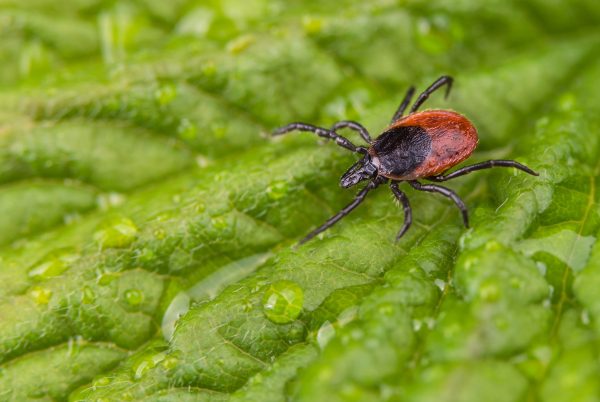7 Tips on How to Prevent Ticks in the Yard

Ticks and the diseases they carry pose a threat to the health of your family and pets. It’s important to understand how to prevent ticks in your yard and what to do when you find them. As our winters warm, tick season is expanding, and preventing ticks becomes a bigger concern in more parts of the country. Let’s explore some essential information about ticks and the potential harm they represent. Then we’ll dive into our seven tips on how to prevent ticks in your yard.
First, Understanding Different Kind Of Ticks
Out of approximately 850 species of ticks worldwide — over 90 can be found in the United States. However, most tick species don’t bite humans, though they do feed on our pets. The ticks that are most likely to bite people and transmit disease are:
- American dog tick also called a wood tick
- Blacklegged tick, also called a deer tick
- Brown dog tick
- Gulf Coast tick
- Lone star tick
- Rocky Mountain wood tick
- Western black-legged tick
Fortunately, tick-preventing techniques are equally effective for all varieties.
Why Is It Important to Efficiently Control Ticks?
It’s true that most ticks don’t bite humans, and those that do, don’t always transmit disease. However, don’t skip learning how to prevent ticks because you like your odds! Every tick bite sucks the blood from its warm-blooded host, whether wildlife, pets, or people. While doing so, they cut a hole in the skin to insert a barbed feeding tube.
If not removed, a tick will remain attached to its host, feeding on blood for seven to ten days. Unless the tick is removed properly, tugging stimulates the tick to salivate and regurgitate into the host’s bloodstream. Meanwhile, improper removal may cause the tick’s head and jaws to pop off the body and remain embedded in the host.
Even when they don’t transmit diseases like Lyme disease and Rocky Mountain spotted fever, tick bites get infected and can cause anemia for your family members and pets. So, let’s see how to prevent ticks in your yard.
7 Tips for Preventing Ticks in the Yard
The following tips will help you in preventing ticks in the yard and keeping your family and pets safe from these nasty biters:
- Cut down on hiding places for ticks by keeping the grass mowed, shrubs and trees trimmed, weeds pulled, and leaf litter picked up and discarded.
- Move swing sets and sandboxes away from wooded areas.
- Keep fences and other barriers to wildlife in good repair. A tick can ride in on an animal, drop off and be ready to bite your pet.
- Create a barrier between the lawn and garden areas and any surrounding woods by laying down gravel or cedar wood chips.
- Don’t overwater. Ticks are attracted to moisture.
- Keep bird feeders, bird baths, and squirrel feeders well away from pet areas.
- Schedule professional tick control services.
Additional Steps to Preventing Ticks from Biting
Most Americans who get bitten by ticks pick them up in their own garden. That’s why it is so important to learn how to prevent ticks in the yard. However, ticks are commonly found at most of our favorite outdoor destinations, including the mountains, the woods, and beaches. Let’s consider additional steps to prevent ticks from ruining your outdoor fun .
Know When to Apply Tick Spray
Consider using a tick-repellant spray with a concentration of 20-30% DEET. Several on the market are effective at preventing tick bites on hiking and camping trips for people and dogs. When it is tick season in the area, a repellant spray is an excellent way to protect your family on vacation.
Know Which Areas to Avoid
Do some basic Google research to learn whether you live, work, or vacation in an area with tick infestations. This knowledge can help you prioritize your tick prevention efforts.
Dress Accordingly
If you go hiking or camping in an area where ticks are a problem, wear light-colored clothing, so tiny ticks are easier to spot. Also, choose clothing that covers your skin, including long sleeves, a high neck, long pants with the legs tucked into your socks, full-coverage shoes, and a hat. Using a DEET tick repellant spray and then dressing carefully is the best approach to preventing tick bites while hiking and camping.
Remain Vigilant for Ticks and Bites
As important as preventing ticks in the yard is, it’s vital to avoid an infestation in your home. Take care to inspect yourself, your kids, and your pets when coming in from exposure to ticks. Shower or bathe to easily dislodge any ticks that have not attached. Then, carefully search for ticks, with particular attention given to the following areas:
- Neck
- Under arms
- Behind ears
- Behind knees
- Inside elbow joints
- Under hair and on the scalp
- Inside the belly button
- Around the waist
- Groin area
When examining pets, run your hands along their skin, feeling for bumps. Check the spots listed above and your pet’s mouth, ears, and between their toes.
Have Routine Tick Control Treatment by a Trusted Specialist
A professional tick control service makes preventing ticks in your lawn and garden much easier. Together with our tips above about denying ticks a habitat in your yard will help to keep ticks from taking over your property.
Contact Mosquito Joe for Tick Control!
Mosquito Joe provides more than effective and efficient mosquito control service and flea control. We have also been providing reliable tick control since 2010. As a proud Neighborly company, we have made it our business to become the local pest control experts in neighborhoods across the county.
When you hire Mosquito Joe, you trust that your service will be done right and on time. Every visit is backed by the Neighborly Done Right Promise and the Mosquito Joe® Satisfaction Guarantee!
At Mosquito Joe, preventing ticks from feeding on your family is our business. Call us today at 1-855-275-2563 or contact us online for a free quote or to schedule professional tick control services. We make your pool, patio, and yard safe for bite-free fun!



